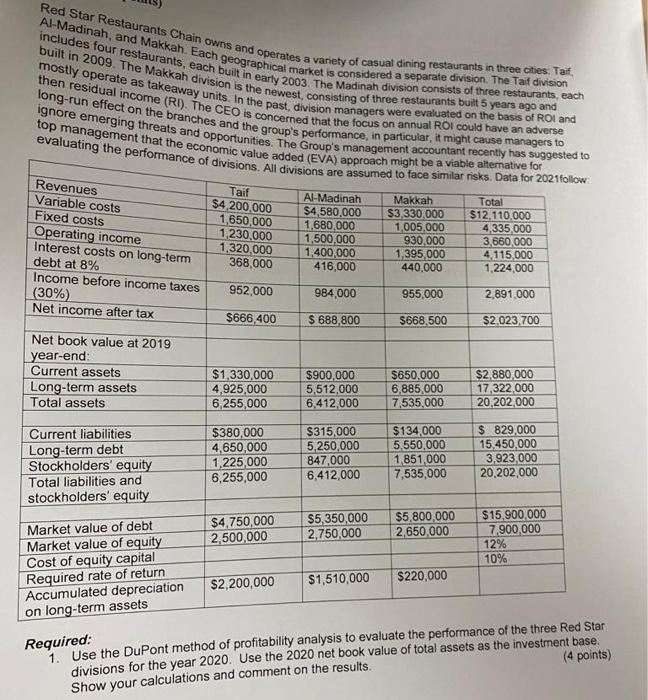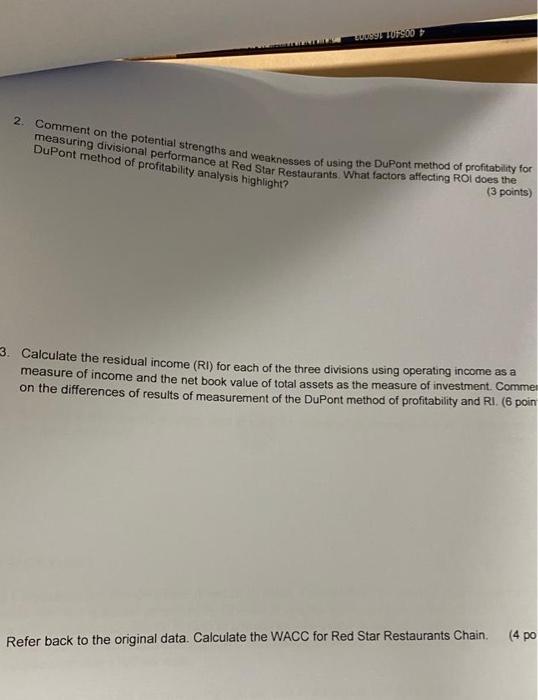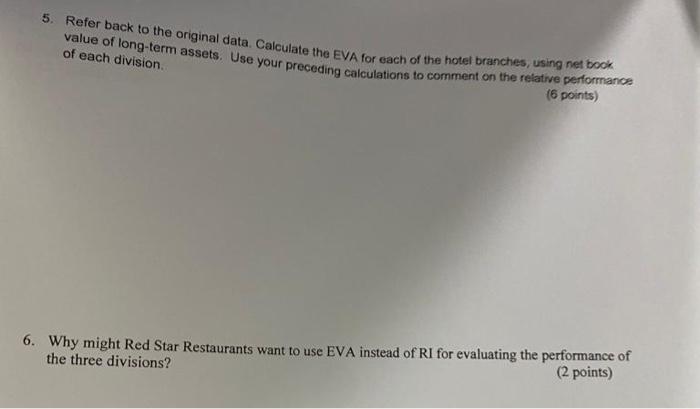Red Star Restaurants Chain owns and operates a variety of casual dining restaurants in three cities: Tail includes four restaurants, each built in early 2003. The Madinah division consists of three restaurants, each Al-Madinah, and Makkah. Each geographical market is considered a separate division. The Taf division built in 2009. The Makkah division is the newest, consisting of three restaurants built 5 years ago and mostly operate as takeaway units. In the past, division managers were evaluated on the basis of ROI and then residual income (RI). The CEO is concerned that the focus on annual ROI could have an adverse long-run effect on the branches and the group's performance, in particular, it might cause managers to ignore emerging threats and opportunities The Group's management accountant recently has suggested to top management that the economic value added (EVA) approach might be a viable alternative for evaluating the performance of divisions. All divisions are assumed to face similar risks. Data for 2021follow Taif Revenues $4,200.000 Variable costs 1,650,000 Fixed costs 1.230,000 Operating income 1,320,000 Interest costs on long-term 368,000 debt at 8% Income before income taxes 952,000 (30%) Net income after tax $666,400 Al-Madinah $4,580.000 1.680,000 1,500,000 1,400,000 416,000 Makkah $3,330,000 1,005,000 930,000 1,395,000 440.000 Total $12,110,000 4,335,000 3,660,000 4,115,000 1,224,000 984,000 955,000 2,891,000 $ 688.800 $668,500 $2,023,700 Net book value at 2019 year-end: Current assets Long-term assets Total assets $1,330,000 4,925,000 6,255,000 $900.000 5,512.000 6,412,000 $650.000 6,885,000 7,535,000 $2.880,000 17,322,000 20,202,000 Current liabilities Long-term debt Stockholders' equity Total liabilities and stockholders' equity $380,000 4,650,000 1,225,000 6,255,000 $315,000 5,250,000 847,000 6,412,000 $134,000 5,550,000 1,851,000 7,535,000 $ 829,000 15,450,000 3,923,000 20,202,000 $4,750,000 2,500,000 $5,350,000 2,750,000 $5,800,000 2.650.000 $15,900,000 7.900.000 12% 10% Market value of debt Market value of equity Cost of equity capital Required rate of return Accumulated depreciation on long-term assets $2,200,000 $1,510,000 $220,000 Required: 1. Use the DuPont method of profitability analysis to evaluate the performance of the three Red Star divisions for the year 2020. Use the 2020 net book value of total assets as the investment base. Show your calculations and comment on the results (4 points) UUSI TUFOOT 2. Comment on the potential strengths and weaknesses of using the DuPont method of profitability for measuring divisional performance at Red Star Restaurants What factors affecting ROI does the DuPont method of profitability analysis highlight? (3 points) 3. Calculate the residual income (RI) for each of the three divisions using operating income as a measure of income and the net book value of total assets as the measure of investment. Commer on the differences of results of measurement of the DuPont method of profitability and RI (6 poin Refer back to the original data. Calculate the WACC for Red Star Restaurants Chain (4 po 5. Refer back to the original data Calculate the EVA for each of the hotel branches, using netbook value of long-term assets. Use your preceding calculations to comment on the relative performance of each division (6 points) 6. Why might Red Star Restaurants want to use EVA instead of RI for evaluating the performance of the three divisions? (2 points) Red Star Restaurants Chain owns and operates a variety of casual dining restaurants in three cities: Tail includes four restaurants, each built in early 2003. The Madinah division consists of three restaurants, each Al-Madinah, and Makkah. Each geographical market is considered a separate division. The Taf division built in 2009. The Makkah division is the newest, consisting of three restaurants built 5 years ago and mostly operate as takeaway units. In the past, division managers were evaluated on the basis of ROI and then residual income (RI). The CEO is concerned that the focus on annual ROI could have an adverse long-run effect on the branches and the group's performance, in particular, it might cause managers to ignore emerging threats and opportunities The Group's management accountant recently has suggested to top management that the economic value added (EVA) approach might be a viable alternative for evaluating the performance of divisions. All divisions are assumed to face similar risks. Data for 2021follow Taif Revenues $4,200.000 Variable costs 1,650,000 Fixed costs 1.230,000 Operating income 1,320,000 Interest costs on long-term 368,000 debt at 8% Income before income taxes 952,000 (30%) Net income after tax $666,400 Al-Madinah $4,580.000 1.680,000 1,500,000 1,400,000 416,000 Makkah $3,330,000 1,005,000 930,000 1,395,000 440.000 Total $12,110,000 4,335,000 3,660,000 4,115,000 1,224,000 984,000 955,000 2,891,000 $ 688.800 $668,500 $2,023,700 Net book value at 2019 year-end: Current assets Long-term assets Total assets $1,330,000 4,925,000 6,255,000 $900.000 5,512.000 6,412,000 $650.000 6,885,000 7,535,000 $2.880,000 17,322,000 20,202,000 Current liabilities Long-term debt Stockholders' equity Total liabilities and stockholders' equity $380,000 4,650,000 1,225,000 6,255,000 $315,000 5,250,000 847,000 6,412,000 $134,000 5,550,000 1,851,000 7,535,000 $ 829,000 15,450,000 3,923,000 20,202,000 $4,750,000 2,500,000 $5,350,000 2,750,000 $5,800,000 2.650.000 $15,900,000 7.900.000 12% 10% Market value of debt Market value of equity Cost of equity capital Required rate of return Accumulated depreciation on long-term assets $2,200,000 $1,510,000 $220,000 Required: 1. Use the DuPont method of profitability analysis to evaluate the performance of the three Red Star divisions for the year 2020. Use the 2020 net book value of total assets as the investment base. Show your calculations and comment on the results (4 points) UUSI TUFOOT 2. Comment on the potential strengths and weaknesses of using the DuPont method of profitability for measuring divisional performance at Red Star Restaurants What factors affecting ROI does the DuPont method of profitability analysis highlight? (3 points) 3. Calculate the residual income (RI) for each of the three divisions using operating income as a measure of income and the net book value of total assets as the measure of investment. Commer on the differences of results of measurement of the DuPont method of profitability and RI (6 poin Refer back to the original data. Calculate the WACC for Red Star Restaurants Chain (4 po 5. Refer back to the original data Calculate the EVA for each of the hotel branches, using netbook value of long-term assets. Use your preceding calculations to comment on the relative performance of each division (6 points) 6. Why might Red Star Restaurants want to use EVA instead of RI for evaluating the performance of the three divisions? (2 points)









